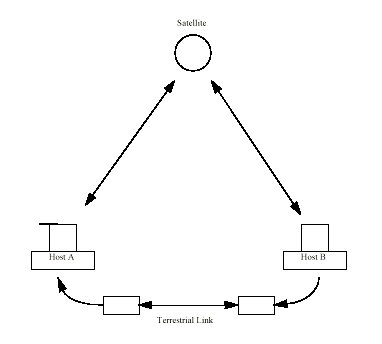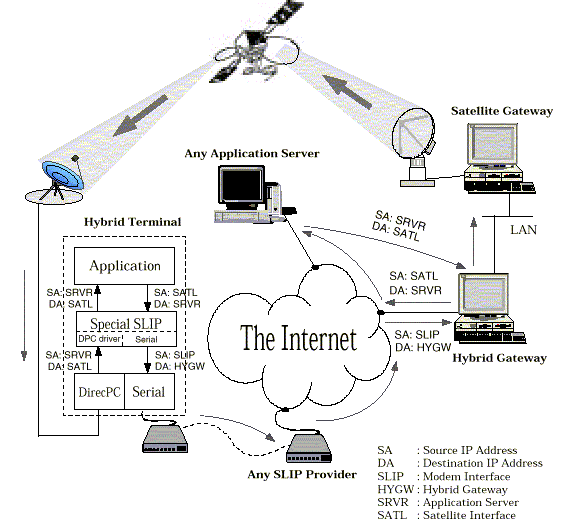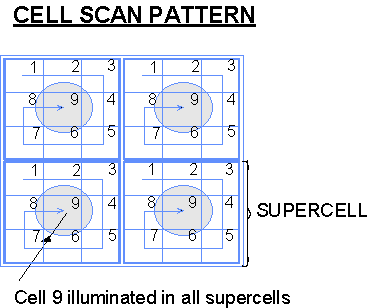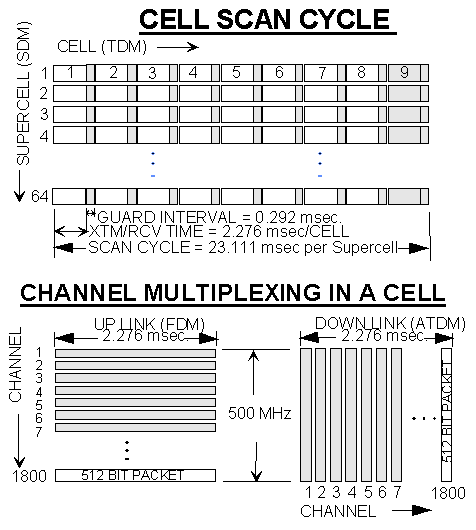Satellite Communications
David Hart,
dhart@cse.wustl.edu
This paper is intended to give an overview of that methods of and uses for satellite communications, in addition to presenting recent trends and future directions in the field
Othet Reports on Recent Advances in Networking
Back to Raj Jain's Home Page
Table of Contents
Introduction
In 1962, the American telecommunications giant AT&T launched the world's first true communications satellite, called Telstar. Since then, countless communications satellites have been placed into earth orbit, and the technology being applied to them is forever growing in sophistication.
Basic Elements
Satellite communications are comprised of 2 main components:
- The Satellite
The satellite itself is also known as the space segment, and is composed of three separate units, namely the fuel system, the satellite and telemetry controls, and the transponder. The transponder includes the receiving antenna to pick-up signals from the ground station, a broad band receiver, an input multiplexer, and a frequency converter which is used to reroute the received signals through a high powered amplifier for downlink. The primary role of a satellite is to reflect electronic signals. In the case of a telecom satellite, the primary task is to receive signals from a ground station and send them down to another ground station located a considerable distance away from the first. This relay action can be two-way, as in the case of a long distance phone call. Another use of the satellite is when, as is the case with television broadcasts, the ground station's uplink is then downlinked over a wide region, so that it may be received by many different customers possessing compatible equipment. Still another use for satellites is observation, wherein the satellite is equipped with cameras or various sensors, and it merely downlinks any information it picks up from its vantagepoint.
- The Ground Station.
This is the earth segment. The ground station's job is two-fold. In the case of an uplink, or transmitting station, terrestrial data in the form of baseband signals, is passed through a baseband processor, an up converter, a high powered amplifier, and through a parabolic dish antenna up to an orbiting satellite. In the case of a downlink, or receiving station, works in the reverse fashion as the uplink, ultimately converting signals received through the parabolic antenna to base band signal.
Back to Table of Contents
Various Uses of Satellite Communications
Traditional Telecommunications
Since the beginnings of the long distance telephone network, there has been a need to connect the telecommunications networks of one country to another. This has been accomplished in several ways. Submarine cables have been used most frequently. However, there are many occasions where a large long distance carrier will choose to establish a satellite based link to connect to transoceanic points, geographically remote areas or poor countries that have little communications infrastructure. Groups like the international satellite consortium Intelsat have fulfilled much of the world's need for this type of service.
Cellular
Various schemes have been devised to allow satellites to increase the bandwidth available to ground based cellular networks. Every cell in a cellular network divides up a fixed range of channels which consist of either frequencies, as in the case of FDMA systems, or time slots, as in the case of TDMA. Since a particular cell can only operate within those channels allocated to it, overloading can occur. By using satellites which operate at a frequency outside those of the cell, we can provide extra satellite channels on demand to an overloaded cell. These extra channels can just as easily be, once free, used by any other overloaded cell in the network, and are not bound by bandwidth restrictions like those used by the cell. In other words, a satellite that provides service for a network of cells can allow its own bandwidth to be used by any cell that needs it without being bound by terrestrial bandwidth and location restrictions.
Television Signals
C-band
C-Band (3.7 - 4.2 GHz) - Satellites operating in this band can be spaced as close as two degrees apart in space, and normally carry 24 transponders operating at 10 to 17 watts each. Typical receive antennas are 6 to 7.5 feet in diameter. More than 250 channels of video and 75 audio services are available today from more than 20 C-Band satellites over North America. Virtually every cable programming service is delivered via C-Band.
SBCA
Ku-Band
- Fixed Satellite Service (FSS)
Ku Band (11.7 - 12.2 GHz) - Satellites operating in this band can be spaced as closely as two degrees apart in space, and carry from 12 to 24 transponders that operate at a wide range of powers from 20 to 120 watts each. Typical receive antennas are three to six feet in diameter. More than 20 FSS Ku-Band satellites are in operation over North America today, including several "hybrid" satellites which carry both C-Band and Ku-Band transponders. PrimeStar currently operates off Satcom K-2, an FSS or so-called "medium-power" Ku-Band satellite. AlphaStar also uses an FSS-Ku Band satellite, Telestar 402-R.
SBCA
- Broadcasting Satellite Service (BSS)
Ku-Band (12.2 - 12.7 GHz) - Satellites operating in this band are spaced nine degrees apart in space, and normally carry 16 transponders that operate at powers in excess of 100 watts. Typical receive antennas are 18 inches in diameter. The United States has been allocated eight BSS orbital positions, of which three (101, 110 and 119 degrees) are the so-called prime "CONUS" slots from which a DBS provider can service the entire 48 contiguous states with one satellite. A total of 32 DBS "channels" are available at each orbital position, which allows for delivery of some 250 video signals when digital compression technology is employed.
SBCA
DBS
DBS (Direct Broadcast Satellite) -The transmission of audio and video signals via satellite direct to the end user. More than four million households in the United States enjoy C-Band DBS. Medium-power Ku-Band DBS surfaced in the late 1990s with high power Ku-Band DBS launched in 1994.
SBCA
Marine Communications
In the maritime community, satellite communication systems such as Inmarsat provide good communication links to ships at sea. These links use a VSAT type device to connect to geosynchronous satellites, which in turn link the ship to a land based point of presence to the respective nations telecommunications system.
Spacebourne Land Mobile
Along the same lines as the marine based service, there are VSAT devices which can be used to establish communication links even from the world's most remote regions. These devices can be hand-held, or fit into a briefcase. Digital data at 64K ISDN is available with some (Inmarsat).
Satellite Messaging for Commercial Jets
Another service provided by geosyncronous satellites are the ability for a passenger on an airbourne aircraft to connect directly to a landbased telecom network.
Global Positioning Services
Another VSAT oriented service, in which a small apparatus containing the ability to determine navigational coordinates by calculating a triangulating of the signals from multiple geosynchronous satellites.
Back to Table of Contents
Technological Overview
Satellites for Data
Characteristics
Incorporating satellites into terrestrial networks is often hindered by three characteristics possessed by satellite communication.
- Latency (propagation delay): Due to the high altitudes of satellite orbits, the time required for a transmission to navigate a satellite link (more than 2/10ths of a second from earth station to earth station) could cause a variety of problems on a high speed terrestrial network that is waiting for the packets.
- Poor Bandwidth: Due to radio spectrum limitations, there is a fixed amount of bandwidth allocable to satellite transmission.
- Noise:A radio signals strength is in proportion to the square of the distance traveled. Due to the distance between ground station and satellite, the signal ultimately gets very weak. This problem can be solved by using appropriate error correction techniques, however.
SULU
Error Correction
Due to the high noise present on a satellite link, numerous error correction techniques have been tested in on such links. They fall into the two categories of forward-error-correction (FEC) and automatic-repeat-request (ARQ):
- Forward-error-correction (FEC)
In this method a certain number of information symbols are mapped to new information symbols, but in such a way as to get more symbols than were original had. When these new symbols are checked on the receiving end, the redundant symbols are used to decipher the original symbols, as well as to check for data integrity. The more redundant symbols that are included in the mapping, the better the reliability of the error correction. However it should be noted that the more redundant symbols that are used to achieve better integrity, the more bandwidth that is wasted. Since this method uses relatively a large amount redundant data, it may not be the most efficient choice on a clear channel. However when noise levels are high, FEC can more reliably ensure the integrity of the data.
- Automatic-repeat-request (ARR)
In this method, data is broken into packets. Within each packet is included an error checking key. This key is often of the cyclic redundancy check (CRC) sort. If the error code reflects a loss of integrity in a packet, the receiver can request the sender to resend that packet. ARR is not very good in a channel with high noise, since many retransmissions will be required, and the noise levels that corrupted the initial packet will be likely to cause corruption in subsequent packets. ARR is more suitable to relatively noise free channels.
- Stop and Wait (SW)
With this form of ARR, the sender must wait for an acknowledgement of each packet before it can send a new one. This can take upwards of 4/10ths of a second per packet since it takes 2/10ths seconds for the receiver to get the packet an another 2/10th seconds for the sender to receive the acknowledgement.
- Go-back-N (GBN)
This method of ARR is an improvement over stop and wait in that it allows the sender to keep sending packets until it gets a request for a resend. When the sender gets such a request, it sends packets starting at the requested packet over again. It can again send packets until it receives another retransmit request, and so on.
- Selective-repeat (SR)
This ARR protocol is an improvement over GBN in that it allows the receiver to request a retransmit of only that packet that it needs, instead of that packet and all that follows it. The receiver, after receiving a bad packet and requesting a retransmit, can continue to accept any good packets that are coming. This method is the most efficient method for satellite transmissions of the three ARR methods discussed.
ARR methods can be demonstrated to provide a usable error correction scheme, but it is also the most expensive, in terms of hardware. This is in part due to the buffering memory that is required, but more importantly to the cost of the receiver, which needs to be able to transmit re-requests. Systems such as the Digital Broadcast Satellites used for television signal distribution would become inordinately expensive if they had to make use of ARR, since the home based receiver would now need to be a transmitter, and the 18 inch dish would be inadequate for the requirements of transmitting back to a satellite.
Hybrid Networks
In today's global networking landscape, there are many ways to transmit data from one place to another. It is desirable to be able to incorporate any type of data transmission media into a network, especially in networks that encompass large areas. A hybrid network is one that allows data to flow across a network, using many types of media, either satellite, wireless or terrestrial, transparently. Since each type of media will have different characteristics, it is necessary to implement a standard transmission protocol. One that is normally used in hybrid networks is TCP/IP. In addition, much work is being done to use TCP/IP over ATM for the satellite segments of hybrid networks, about which more will be discussed later.
One way to get around the need in ARR for the receiver to have to request retransmit via an expensive and slow satellite link is to use a form of hybrid network. In one form of hybrid network, the reciever transmits its requests back to the sender via a terrestrial link. Terrestrial link allows for quicker, more economical and less error prone transmission from the reciever, and the costs associated with the receivers hardware are greatly reduced when compared to the costs involved if it had to transmit back over the satellite link. There are products on the market today that allow a home user to get intenet access at around 400MB via digital satellite, while its retransmit signals are sent via an inexpensive modem or ISDN line.

In fact, a product currently being marketed by Direct PC called Turbo Internet uses a form of hybrid network. The system uses two network interfaces; one connects via a special ISA bus PC adapter to a receive-only Very Small Aperture Terminal (VSAT), while the other is a modem attached to a serial port. Inbound traffic comes down to the VSAT, while outbound traffic goes through the modem link. The two interfaces are combined to appear as a single virtual interface to upper layer TCP/IP protocol stacks by a special NDIS compliant driver. The Serial Line Internet Protocol (SLIP) is used to connect the modem-based link with an internet service provider. Packets, which are encapsulated by the terminal such that the desired ip address of the destination host is embedded underneath the IP address of the Direct PC Gateway, to which all packets leaving the terminal must go. Once at the gateway, the outer packet is stripped, and the gateway contacts the destination address within. Upon the gateway's receiving the request from the host, it then prepares the packet for satellite transmission, which is then used to send the packet back to the terminal.

This Picture's Source: Vivek Arora, Narin Suphasindhu, John S. Baras, Douglas Dillon
Back to Table of Contents
ATM Over Satellite
There are problems, however. ATM's relatively large propagation delays can significantly increase the latency of feedback mechanisms essential for congestion control. acquisition time, cell in-synch time and cell discard probability
(BARAS).Solutions to these issues are still being explored.
The group that is currently working to develop interoperability specifications that facilitate ATM access and ATM network interconnect in both fixed and mobile satellite networks is known as The TIA/SCD/CIS - WATM group. As of March, 1997 they have proposed the following standards:
- SATATM Type 1 - Fixed ATM Direct Access
Fixed network access via satellite that is characterized by a large number of small inexpensive user terminals and a small number of gateway earth stations. Provides for a radio interface of 64 kbit/s - NxE1 and a service interface of 2.4 kbit/s - NxE1 while providing no mobility support
- SATATM Type 2 - Fixed ATM Network Interconnect
High speed interconnections using PNNI, B-ICI, or Public UNI between earth stations and fixed ATM networks.
Allows for a radio interface of T1 - 1.2 Gbit/s but provides no mobility support.
- SATATM Type 3 - Mobile ATM Direct Access
ATM network access by mobile terminals. The radio interface provides for 64 kbit/s - E1 for moving, 64 kbit/s - NxE1 for portable terminals and the rervice interfaceallows for 75 bit/s - E1 for moving, 75 bits/s - NxE1 for portable terminals.
- SATATM Type 4 - Mobile ATM Network Interconnect
High speed interconnections between mobile and fixed networks or between two mobile networks providing fast moving land-mobile data rates < NxE1 and slow-moving airborne data rates of < 622 Mbit/s.
The group also has established requirements for dealing with the physical layer, the media access control layer and the data link control layer.
SATIN - Satellite Integrated Terrestrial Network:
The goal of SATIN is to create a fully integrated hybrid network in which the method of communication, which can incorporate networks of local, metropolitan and wide area scope, Broadband ISDN, Integrated Network Management, AIN (Advanced Intelligent Networks) and PCS (Personal Communications Services), in addition to ATM (Asynchronous Transfer Mode) over satellite, is totally transparent to the user. The difficulties inherent in this are obvious. Differences in latency, noise, bandwidth and reliability must be equalized in all the media that will encompass the network.
VSAT Networks
VSAT stands for Very Small Aperture Terminal. Although this acronym has been used amongst telecom groups for some time now to describe small earth stations, the concepts of VSAT are being applied to modern hand held satellite communications units, such as GPS (Global Positioning System), portable Inmarsat phones and other types of portable satellite communication devices.
Orbits
GEO
GEO stands for Geostationary Earth Orbit. This refers to satellites that are placed in orbit such that they remain stationary relative to a fixed spot on earth. If a satellite is placed at 35,900 km above the earth, its angular velocity is equal to that of the earth, thereby causing it to appear to be over the same point on earth. This allows for them to provide constant coverage of the area and eliminate blackout periods of ordinary orbiting satellites, which is good for providing television broadcasting. However their high altitude causes a long delay, so two way communications, which would need to be uploaded and then downloaded over a distance of 72,000 km, are not often used with this type of orbit.
LEO
LEO stands for Low Earth Orbit, and it refers to satellites in orbit at less that 22300 miles above the earth. This type of an orbit reduces transmission times as compared to GEO. A LEO orbit can also be used to cover a polar region, which the GEO cannot accomplish. Since it does not appear stationary to earth stations, however, earth stations need an antenna assembly that will track the motion of the satellite.
Constellations
References
Web Sites
- Intelsat
- Inmarsat, http://www.inmarsat.org/
- Iridium
- Teledesic
- ATM by Satellite
http://www.telesat.ca/
- SATELLITE COMMUNICATIONS NETWORK TECHNOLOGY
- Satellite Broadcasting and Communications Association
- DBS DISH Satellite News and Informationhttp://www.dbsdish.com/
- High Bandwidth Web Page:http://www.specialty.com/hiband/satellite_index.html
- The Center for Satellite and Hybrid Communication Networks:
http://www.isr.umd.edu/CSHCN/
- Low Earth Orbiting Satellites and Internet-Based Messaging Services:
http://www.isoc.org/isoc/whatis/conferences/inet/96/proceedings/g1/g1_1.htm
- SATELLITE COMMUNICATIONS IN THE 21ST CENTURY: http://www.hughes.com/speeches/century21.html
- Analysis: Telecoms Virtual Library: http://www.analysys.com/vlib/satellit.htm
- Big LEO Overview:
http://www.idt.unit.no/
- Centre for Satellite Engineering Research:
http://www.ee.surrey.ac.uk/SSC/CSER/
- Lloyd's satellite constellations
http://www.sat-net.com/L.Wood/constellations/
Books and Papers
- Daniel E. Friedman, Masters Thesis: "Error Control for Satellite and Hybrid Communication Networks", directed by Daniel E. Friedman, 1995
- Vivek Arora, Narin Suphasindhu, John S. Baras, Douglas Dillon, "Effective Extensions of Internet in Hybrid Satellite-Terrestrial Networks", University of Maryland at College Park & Hughes Network Systems, Inc., 1996
- Tom Logsdon, "Mobile Communication Satellites", McGraw Hill Text, February 1995
- Dennis Roddy, "Satellite Communications", McGraw Hill Text, 1995
- TIA/SCD/CIS - WATM WG Meeting Overview, 3/26/97
- Deepak Ayyagari and Anthony Ephremides, "Enhancement of Cellular Service via the use of Satellite Capacity," University of Maryland, 1995
- Pelton, Joseph N., "Wireless & Satellite Telecommunications: The Technology, the Market, & the Regulations", Prentice Hall 1995
- Cochetti, Roger, "Mobile Satellite Communications Handbook", Quantum Publishing, Incorporated 1995
- Michael J. Miller (Editor),Branka Vucetic (Editor),Les Berry (Editor) , "Satellite Communications: Mobile & Fixed Services" Kluwer Academic Publishers, 1993
- Gerard Maral,Michel Bousquet, "Satellite Communication System: Systems, Techniques & Technology", John Wiley & Sons, Incorporated, 1993
- Wood, James, Satellite communications and DBS systems. Boston : Focal Press, 1992.
- Elbert, Bruce R, The satellite communication applications handbook, Boston, MA : Artech House, 1997.
- Miller, Michael J., Vucetic, Branka., Satellite communications : mobile and fixed services, Boston : Kluwer Academic Publishers, c1993
- Satellite communications systems and technology--Europe, Japan, Russia / Burton I. Edelson ... [et al.], Park Ridge, N.J., U.S.A. : Noyes Data Corp., c1995
- Broadband communications : global infrastructure for the information age / proceedings of the International IFIP-IEEE Conference on Broadband Communications, Canada, 1996 ; edited by Lorne Mason and Augusto Casaca., London : Chapman and Hall on behalf of the International Federation for Information Processing, 1996
- Litva, J. (John), Digital beamforming in wireless communications, Boston : Artech House, c1996.
- Lindberg, Bertil C., Digital broadband networks and services, New York : McGraw-Hill, 1995
- International journal of satellite communications., Chichester, Sussex : Wiley, c1983-
- Feldman, Phillip M., An overview and comparison of demand assignment multiple access (DAMA) concepts for satellite communications networks Santa Monica, CA : RAND, 1996
- Maral, Gerard., VSAT networks, Chichester, West Sussex, England ; New York : Wiley, c1995.
Back to Table of Contents
Last Modified: 14 August 1997



